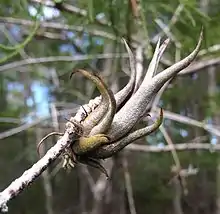Tillandsia paucifolia
Tillandsia paucifolia, the potbelly airplant,[3] is a species of bromeliad in the genus Tillandsia.[4] This species is native to Central America, central and southern Mexico, Venezuela, Colombia, the West Indies, and Florida.[5][6][7][8][9][10][11]
| Tillandsia paucifolia | |
|---|---|
 | |
| Tillandsia paucifolia on a slash pine tree in Fort Myers, Florida | |
| Scientific classification | |
| Kingdom: | |
| (unranked): | |
| (unranked): | Monocots |
| (unranked): | |
| Order: | |
| Family: | |
| Subfamily: | |
| Genus: | |
| Subgenus: | |
| Species: | T. paucifolia |
| Binomial name | |
| Tillandsia paucifolia | |
| Synonyms | |
|
Tillandsia bracteosa Klotzsch ex Beer | |
Tillandsia paucifolia can either grow singularly or in clusters and typically have five to ten leaves. The leaves of this species of Tillandsia are light green and silver-gray in color and are short with tapered ends. T. paucifolia have a large bulbous base which distinguishes them from other Tillandsias. The leaves of T. paucifolia are covered in trichomes, which are hair-like structures that increase the surface area on the leaves to maximize nutrient and water absorption from the air. The particular trichomes of the Tillandsia paucifolia are exceptionally sizable and copious.[12]
Reproduction
Tillandsia paucifolia are angiosperms[13] with flowers that range from a pale pink to a lavender-blue color. Flowers of these epiphytes can be animal-pollinated.[14] Animals such as bees, beetles, and hummingbirds are known to pollinate T. paucifolia diurnally (during the day) while there have been reports of moths and bats that pollinate nocturnally.[15] As a reward to the animals that facilitate the pollination, these angiosperms will sometimes produce nectar.[14] With increased visitation from animal pollinators, these epiphytes are more likely to receive more genetically varying pollen, leading to better quality seeds.[14]
Hosts
Tillandsia paucifolia are vascular epiphytes that lack traditional roots like other plants. Their roots serve primarily to secure themselves to the trees that they reside on.[16] T. paucifolia found in southwest Florida mainly inhabit slash pine trees although they are not host-specific and can be seen growing on numerous other trees. Although T. paucifolia are not parasitic and only use their host trees as support, there can be adverse effects when present in large numbers and in certain parts of the trees.[16] Heavily infested host trees can undergo states of nutritional stress caused by these epiphytes (Benzing 1978). When present in large numbers, T. paucifolia can also cause limb breakage and excess shade on their host trees.[16]
Cultivars
See also
References
- "Tillandsia paucifolia Baker". Plants of the World Online. The Trustees of the Royal Botanic Gardens, Kew. n.d. Retrieved July 18, 2020.
- "Tillandsia paucifolia Baker". World Flora Online. The World Flora Online Consortium. n.d. Retrieved July 18, 2020.
- "Tillandsia paucifolia". Natural Resources Conservation Service PLANTS Database. USDA. Retrieved 10 December 2015.
- Robertson, K.M; Platt, W.J. (2001). "Effects of multiple disturbances (fire and hurricane) on epiphyte community dynamics in a subtropical forest, Florida, U.S.A". Biotropica. 33 (4): 573–582. doi:10.1111/j.1744-7429.2001.tb00216.x.
- Kew World Checklist of Selected Plant Families
- An Annotated Checklist of the Bromeliaceae of Costa Rica retrieved 3 November 2009
- Checklist of Mexican Bromeliaceae with Notes on Species Distribution and Levels of Endemism Archived 2007-10-30 at the Wayback Machine retrieved 3 November 2009
- Checklist of Venezuelan Bromeliaceae with Notes on Species Distribution by State and Levels of Endemism retrieved 3 November 2009
- Bromeliaceae of the United States (excluding Puerto Rico and the Virgin Islands) retrieved 30 October 2009
- Biota of North America Program, 2013 county distribution map
- Flora of North America, Tillandsia paucifolia Baker, Gard. Chron. ser. 2, 10:748. 1878.
- Nyman, L.P; Davis, S.J.; O'Dell, J.; Arditti, G.; Stephens, C.; Benzing, D.H. (1987). "Active uptake of amino acids by leaves of an epiphytic vascular plant, Tillandsia paucifolia (bromeliacea)". Plant Physiology. 83 (3): 681–684. doi:10.1104/pp.83.3.681. PMC 1056425. PMID 16665307.
- Papini, A.; Mosti, S.; Milocani, E.; Tani, G.; Di Falco, P.; Brighigna, L. (2010). "Megasporogenesis and programmed cell death in tillandsia (bromeliacea)". Protoplasma. 248 (4): 651–662. doi:10.1007/s00709-010-0221-x. PMID 20978809. S2CID 25228066.
- Ordano, M.; Ornelas, J.F. (2004). "Generous-like flowers: nectar production in two epiphytic bromeliads and a meta-analysis of removal effects". Oecologia. 140 (3): 495–505. Bibcode:2004Oecol.140..495O. doi:10.1007/s00442-004-1597-0. PMID 15221434. S2CID 22853944.
- Aguilar-Rodriquez, P.; MacSwiney, M.C.; Kromer, T.; Garvia-Franco, J.G.; Knauer, A.; Kessler, M. (2014). "First record of bat-pollination in the species-rich genus Tillandsia (bromeliaceae)". Annals of Botany. 113 (6): 1047–1055. doi:10.1093/aob/mcu031. PMC 3997647. PMID 24651370.
- Benzing, D.H.; Bermudes, D. (1991). "Epiphytic bromeliads as air quality monitors in South Florida". Selbyana. 12: 46–53.
- BSI Cultivar Registry Retrieved 11 October 2009